Dillon Read (16): Cashing Out On Cornell
A Serialised Story - Part 16 of 20 (publishing August/September 2007)
Dillon Read & Co. Inc.
And the Aristocracy of Stock
Profits
By Catherine Austin
Fitts
Click Here For Links To Other
Chapters
http://www.scoop.co.nz/stories/HL0708/S00302.htm#2
Chapter 15: Dillon Read — Cashing Out on Cornell
When Cornell Corrections listed its shareholders with investments of greater than 5% in its proxy statement filed with the SEC in March 1998, Dillon Read was no longer listed. Making the assumption that Dillon Read and its various funds and officers and directors cashed out at or between the second Cornell offering in October 1997 and early 1998 when this proxy was filed, we can pause in the telling of our story to estimate the total profits to Dillon and their investors. We should first note that it appears that Dillon sold their shares at a historical high for Cornell’s stock price.
| 1996 | High | Low |
| Fourth Quarter (from October 3) | $12 3/4 | $8 7/8 |
| 1997 |
|
|
| First Quarter | $11 5/8 | $9 |
| Second Quarter | $18 | $9 |
| Third Quarter | $16 3/4 | $14 7/16 |
| Fourth Quarter | $20 3/4 | $15 3/4 |
| 1998 |
|
|
| First Quarter | $24 5/8 | $19 1/4 |
| Second Quarter | $25 7/16 | $18 1/2 |
| Third Quarter | $21 1/16 | $8 |
| Fourth Quarter | $19 | $11 |
| 1999 |
|
|
| First Quarter | $19 7/8 | $13 |
| | ||

While Dillon was not required to disclose their total investment banking revenues and investment profits on Cornell Corrections between 1991 and 1998, I estimate Dillon’s total profits for their stock investment in Cornell to have been $6.7 million for Dillon employees who invested and $19.4 million for the investors in Dillon’s funds, which also included Dillon officers and directors. This represented an annual return on investment of approximately 35-45%. These are the kind of profits you get when you buy stock for a price of $3.8 million and several years later sell that stock for $29.9 million — or an almost 800% increase on your investment. In addition, I estimate that Dillon also generated at least $6 million in fees for investment banking and investment advisor services. This results in an estimated total of $32.1 million in profits for Dillon, its leaders and its investors over a seven-year period.
Dillon Read Profits on Cornell - An Example of How to Estimate "Prison Pop"
**** # # # **** Dillon Read’s Estimated Total Profits on Cornell Corrections: $32.1 Million
PROFIT #1:
Estimate of Dillon Read Profits on Stock Investments:$26.1 Million – Return on Investment (ROI) for Dillon Investors of Est. 35-45% -- Representing 8X Increase on Investment
EXPLANATION: Cornell’s October 1996 Prospectus describes Dillon and its funds as having a stock position of 1,359,863 shares. Dillon's April 1997 Cornell 13-D filling describes shareholdings of 1,191,864 shares and an original cost of $3,359,736. The difference appears to be a distribution of shares to the Concord partners in early 1997. We assume that this distribution was 168,000 shares and for purposes of estimating cost, assume their average purchase price on these shares was $2.75 average cost per share for all existing shareholders (Dillon managed funds and employees were approximately 44% of existing shareholders) in Cornell’s October 4, 1996 Prospectus. (A prospectus is the document provided to investors that describes the company and its securities.)
Dillon did not appear to sell shares in the October 4, 1996 or the October 10, 1997 offering, yet was not shown as a holder of 5% or more in the March 9, 1998 proxy. (A proxy is the annual filing soliciting annual shareholder votes that describes the stock holdings of officers and directors as well as any holder known to the company to have 5% or more of the outstanding shares.)
For purposes of estimation, we are assuming that stock options can be treated as shares and Dillon and partners to whom they distributed shares sold their various positions between October 10, 1997 and March 1997 at or between the first quarter high of $24 – shown in Cornell’s 1998 10K – or the offering price in October 1997 of $19.625. As a result, we assumed an average sales price of $22.
Under these assumptions, total proceeds would have been $29,916,986. Profits would have been these amounts, less the costs of $3,821,736, or $26,095,250 in capital gains (stock profits). Of this amount, the officer and director personal positions of 335,233 shares (including options) would have been proceeds of $7,375,126 less costs of $652,999.99 ($2.15 per share shown in SEC filings breakdown for costs of the different Dillon positions – which differs by slight amounts than the total of the stock costs listed for the 32 Dillon officers and directors listed as shareholders at Exhibit E in the April 1997 13-D filing), generating estimated profits for officers and directors directly of $6,722,126.
Actual profits will differ from these estimates based on such factors as different timing of investments, sales or stock and option costs.
PROFIT #2:
Estimate of Dillon Read Fees (Underwriting Spreads) on 2 Stock Offerings: $3 MillionEXPLANATION: Total underwriting spreads were $7.5 Million assuming the 30-day option to sell additional shares were exercised. Dillon Read as lead manager would have made the largest portion of all the underwriters in the underwriting syndicates. The underwriters spread is the discount on the purchase price given to the underwriters who buy at the discounted price and then attempt to sell the securities at the higher stated offering price.
PROFIT #3:
Estimate of Dillon Read Secondary Market Profits on Market Making in Cornell Stock: $1 MillionEXPLANATION: When I was at Dillon we often made more money on trading the securities after the initial offering then we did on the initial offering. Because we had placed many of the securities when they were first sold, investors would come to us to buy and sell the shares in the future. Dillon was not traditionally strong in the equity area, so I am assuming a conservative number in this category. Actual profits could be higher.
PROFIT #4:
Estimate of Dillon Fees (Underwriting Spreads) on $30,106,000 Rhode Island Port Authority Municipal Bonds for Donald C. Wyatt Facility & Secondary Market Profits on Market Making in the Bonds: $500,000EXPLANATION: The Harvard design case study indicates the underwriting discount on the municipal bond offering was $451,325 with Dillon Read and Fleet handling the underwriting.[78] Dillon would have made a percent of the underwriting discount and profits on the subsequent aftermarket trading in the bonds. We are assuming that Dillon did not lose money when Cornell had trouble making debt service payments. (See the New York Times story of Al Gore’s office arranging prisoners to be shipped to Rhode Island so that the Cornell revenues would be sufficient to cover debt service on the municipal bonds issued to finance the facility.) The bondholders presumably would have included the investors Dillon and Fleet sold the bonds to.[79]
PROFIT #5:
Dillon Read Private Placement Fees: $500,000EXPLANATION: Cornell had a large credit facility from ING, the Dutch insurance company that took over Barings, and in the process became Dillon’s lead outside investor. It is likely that Dillon arranged for this financing for Cornell and, if so, would have been paid a fee. A “private placement” is done privately between a company and an investor rather than offered to the public.
PROFIT #6:
Dillon Fees Associated with Venture Fund Asset Management: $1 MillionEXPLANATION: Dillon would have charged fees in connection with its raising and management of the Concord, Concord Japan and Lexington Funds. If their fees included a % of the capital gains on the fund and its investments, the Dillon fees related to Cornell investments could have been much greater that this estimate.
TOTAL PROFITS:
Total Estimated Profits: $32.1 Million**** # # # ****
I remember reading some of the Carlyle Group’s marketing material about their success in leveraged buyouts of companies that did lots of contracts and business with the federal government. They claimed to have achieved annual investment returns of 35%, in the range of the returns that I estimate Dillon to have made on Cornell Corrections. If you understand the story of Cornell Corrections, you will get a good understanding of the type of investment that achieves 35% investment returns for private investors on the stocks of companies that enjoy growth in government contracts and the fruits of “privatization.”
It is imperative in understanding investments like these to look not just at the companies involved, but to look through to the individuals who make the critical decisions. In Dillon Read’s case, the key leaders were also personal investors. We do not know if, as sometimes happens in cases like this, the firm financed or arranged financing for their purchases in an arrangement where, in essence, they can buy for “no money down.” An estimate of their personal profits is as follows:
$22 Est. Sales Price **
DILLON INVESTOR | SHARES | OPTIONS | AMOUNT | PROFITS |
| John P. Birkelund | 39,579 | 3,736 | $96,990.16 | $773,748 |
| John Haskell, Jr | 36,730 | 3,505 | 85,382.75 | 722,677 |
| David W. Niemiec | 35,018 | 3,279 | 76,989.51 | 693,406 |
| Fritz Hobbs | 30,455 | 2,803 | 56,986.04 | 613,024 |
| George A. Wiegers | 28,176 | 2,571 | 44,988.85 | 574,883 |
| Peter Flanigan | 28,178 | 2,687 | 48,781.40 | 571,134 |
| Kenneth M. Schmidt | 24,778 | 2,454 | 35,622.38 | 509,494 |
| * Does not
include potential bonus and compensation resulting from
other profits on Cornell Corrections. Treats options as
shares for purposes of estimate. Options are included in
share numbers. |
||||
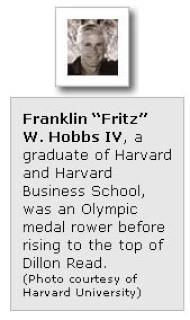
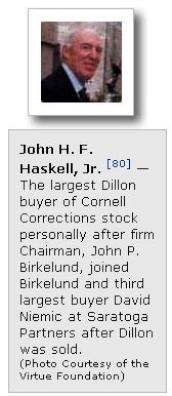
To generate these profits for Dillon and the Dillon leadership at a stock market valuation of $25,962 (the value "per bed" at the time of the October 1997 offering) when Dillon had invested when Cornell had no prisons and prisoners, the following table estimates how many people had to go to prison for an extended period:
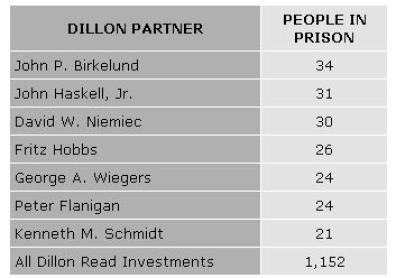
Another useful calculation is to look at the how many taxpayers will have to work their entire lives to pay the taxes for this many people to be imprisoned. Let’s assume that the average taxpayer pays $150,000 of federal taxes in an entire lifetime. Based on the General Accounting Office’s (now the General Accountability Office, the Congressional Auditor) study in 1996 that indicated the total annual federal, state and local system expenditures per prisoner were approximately $154,000. That means that ten taxpayers would have to work their whole lives to pay for one prisoner with a mandatory sentence of ten years. On this basis, the following table estimates how many people would have to work their whole lives to pay the taxes to fund the incarcerations necessary to generate Dillon’s profits on Cornell Corrections.
| DILLON PARTNER | TAXPAYER LIVES |
| John P. Birkelund | 340 |
| John Haskell, Jr. | 310 |
| David W. Niemiec | 300 |
| Fritz Hobbs | 260 |
| George A. Wiegers | 240 |
| Peter Flanigan | 240 |
| Kenneth M. Schmidt | 210 |
| All Dillon Read Officers and Directors Investing |
11,523 |
Cornell’s March 1998 proxy filed with the SEC inspires some additional questions regarding the source of funds that bought Dillon Read out at a price that generated tens of millions of profit on their venture investment. There are several new large shareholders listed:
| J&W
Seligman | 5.7% |
| Alliance
Capital | 5.5% |
| AMVESCAP
| 5.3% |
When Cornell
Corrections filed its 1999 proxy the following year,
AMVESCAP and Alliance were each up to 9% of the outstanding
shares.
Based on the foregoing filings, it is fair to assume one way or another these investors were helpful in making it possible for Dillon Read to cash out at or near a market high in Cornell’s stock price.
John Haskell, the second largest personal investor among the Dillon officers and directors was a board member of Equitable. Alliance Capital was soon to become much more visible as a result of its role in using Florida pension funds to buy Enron stock when one of its executives and Lockheed Martin board members, Frank Savage, was also on Enron’s board and member of its finance committee.[81]
However, in the category of “it’s a small world” was the relationship of Cornell's largest European shareholder AMVESCAP to RJR. In 1999, AD Frazier, President and CEO of INVESCO joined the board of R.J. Reynolds Tobacco Holdings. The press release describes Frazier as a member of the Board of Directors of INVESCO’s parent AMVESCAP.
RJR’s 2003 Proxy, filed after the European Union lawsuits were filed list INVESCO as the third largest shareholder with 5.6% of outstanding shares. RJR’s 2004 Proxy lists INVESCO in London as having 11% and INVESCO North American Holdings as owning 11%. RJR’s 2005 Proxy lists INVESCO in London with 6.3% and AMVESCAP in London with 6.32%.
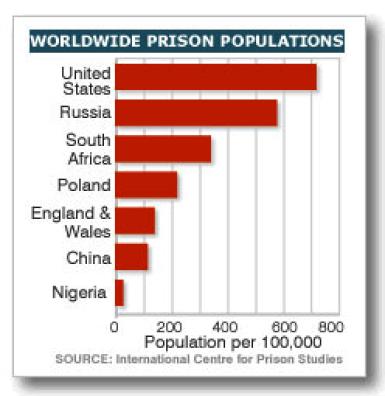
Which means that when one of RJR Nabisco’s former lead investment bankers, Dillon Read, and its investors made in the range of $30 million cashing out of a private prison company, they were cashed out directly or indirectly by one of RJR Nabisco lead investors.
I wonder what the ghost of Barry Seal would say about what that might all have to do with the alleged $5 billion of drugs he pumped through a little airport in Arkansas, and who was responsible to reinvest that money. I wonder what Lou Gerstner, Henry Kravis and George Roberts as CEO and lead investors in RJR would say if given truth serum about who may be responsible for reinvesting the dirty money allegedly laundered with RJR cigarette sales.
Brown University:
Cashing Out on Cornell
Corrections
In Cornell’s prospectus when Dillon Read led its second stock offering on October 10, 1997, Brown University’s Third Century Fund was listed as a shareholder with 88,818 shares, of which 28,818 shares were to be sold through the offering. John Birkelund, Chairman and CEO of Dillon Read, was a long time trustee of Brown University. The price on the 1997 offering was $19 5/8 per share. If Brown’s average profit was the difference between the 1997 price and the 1996 offering price of $12 per share, it would have generated a profit in a year’s time of $677,237. Brown’s return on investment under these assumptions would have been a smashing 63.5%. If it had sold when the stock peaked after the offering at or around the time that Dillon appears to have sold out, it would have been higher.
The number of people who needed to be imprisoned for many years to generate such investment profits based on the foregoing assumptions was 67 people. An estimate of the number of men and women in the U.S. who would have to work their whole life to pay the taxes to imprison those 67 people would be 670 people.
Brown University also benefited from John Birkelund’s success at Dillon Read — including from Cornell Corrections — presumably through his donations and fundraising for the school — a primary function of a trustee. Typically, funding a “chair” at a university requires a donation greater than a million dollars — even several million. According to Brown’s website, there is a John P. Birkelund Professor of History at Brown, Omer Bartov.
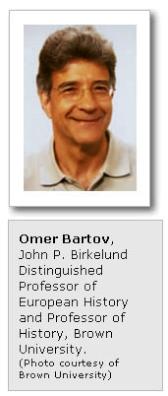 Professor Bartov is
an expert in genocide. His publications listed on Brown’s
website include:
Professor Bartov is
an expert in genocide. His publications listed on Brown’s
website include:
- In God's Name: Genocide and Religion in the Twentieth Century, edited volume with P. Mack (Berghahn Books, 2001).
- Mirrors of Destruction: War, Genocide, and Modern Identity (Oxford UP, 2000)
- The Holocaust: Origins, Implementation, Aftermath, edited volume (Routledge, 2000)
- Murder in Our Midst: The Holocaust, Industrial Killing, and Representation (Oxford UP, 1996)
For the Fall 2005 semester Professor Bartov taught a course called “Modern Genocide and Other Crimes against Humanity.” The course description is as follows:
“The emergence, evolution, varieties, and underlying causes of and confrontations with genocide and other crimes against humanity in the 20th century: genocide in colonial empires, Ottoman Turkey, Nazi Germany, Cambodia, and Rwanda; killing of the handicapped, wartime massacres, mass crimes of Communism, and 'ethnic cleansing'; the role of racism in and moral arguments about crimes against humanity; and policies of retribution and restitution.”
Professor Bartov also serves on the Brown University Slavery and Justice Committee whose mission is described on the University’s website as follows:
“Welcome to the website of Brown University's Steering Committee on Slavery and Justice. The committee was appointed in 2003 by President Ruth Simmons and charged 'to organize academic events and activities that might help the nation and the Brown community think deeply, seriously, and rigorously about the questions raised' by the national debate over slavery and reparations. As an institution whose early benefactors included both slave traders and pioneering abolitionists, Brown has an intimate relationship to the history of American slavery. This history gives us, in the president's words, 'a special opportunity and a special obligation' to contribute to this ongoing debate." [82]
A 2003 press release regarding one of Professor Bartov’s articles describes his work as follows:
“Throughout the last century, the scholarly community played a prominent role in providing the rationale and supplying the know-how and personnel for the perpetration of state-directed mass violence, according to new research by a Brown University historian. Omer Bartov, the John P. Birkelund Distinguished Professor of European History, cited incidents of ethnic cleansing, genocide and terrorism which were legitimized and supported by academics in his paper "Extreme Violence and the Scholarly Community," published in the current issue of the International Social Science Journal. "We must recall that scholars and intellectuals have not infrequently found themselves at the forefront of support for mass crimes and inhumanity and have often distinguished themselves by their extraordinary political blindness and moral callousness,” Bartov wrote. “We ignore its implications at our peril.”
From a survey of Professor Bartov’s research online there is no indication of what his thoughts are regarding Brown’s quick profits on Cornell Corrections or possible sources of funds to support a John P. Birkelund Professorship in European History and the facts and circumstances of John Birkelund’s fortune — including fees and profits from RJR Nabisco and Cornell Corrections.
Professor Bartov was contacted by e-mail at Omer_Bartov@brown.edu for comment in late November 2005 and has not yet replied.
FOOTNOTES[78] Harvard Design School Case Study (http://www.dunwalke.com/resources/documents/ Events/Harvard_Case_Study_940101-014.pdf).
[79] An article by Jeff Gerth and Stephen Labaton in the New York Times in November 1995, Prisons for Profit: A special report; Jail Business Shows Its Weaknesses describes the problems that Cornell ran into on its Rhode Island facility—one which had been financed with municipal bonds issued by Dillon Read:
“Two years ago, the owners of the red cinder-block prison in this poor mill town threw a lavish party to celebrate the prison's opening and show off its computer monitoring system, its modern cells holding 300 beds and a newly hired cadre of guards.
But one important element was in short supply: Federal prisoners.
It was more than an embarrassing detail. The new prison, the Donald W. Wyatt Detention Facility, is run by a private company and financed by investors. The Federal Government had agreed to pay the prison $83 a day for each prisoner it housed. Without a full complement of inmates, it could not hope to survive.
So the prison's financial backers began a sweeping lobbying effort to divert inmates from other institutions. Rhode Island's political leaders pressed Vice President Al Gore while he was visiting the state as well as top officials at the Justice Department to send more prisoners. Facing angry bondholders and insolvency, the company, Cornell Corrections, also turned to a lawyer who was then brokering prisoners for privately run institutions in search of inmates.
The lawyer, Richard Crane, has done legal work for private corrections companies and Government penal agencies. He put the Wyatt managers in touch with North Carolina officials. Soon afterward, 232 prisoners were moved to Rhode Island from North Carolina, and Mr. Crane was paid an undisclosed sum by Cornell Corrections.”
See (http://www.solariactionnetwork.com/phpBB2/viewtopic.php?p=8203&).
[80] The Virtual Foundation describes Haskell, an Advisory member as follows: After graduating from the U.S. military academy at West Point in 1953, Mr. Haskell served in a number of armor branch units in the U.S., Austria, and Germany. In 1958, he received an MBA from Harvard University's Graduate School of Business Administration and later worked as an Associate at Dillon, Read & Co. from 1958 to 1961. He subsequently went to France, where he reopened and managed the Dillon Read European office from 1961 to 1966. From 1964 to 1975 he served as Vice-President of Dillon Read, and from 1975 to 1999 as its Managing Director. In May of 2000, Dillon Read & Co. changed its name to UBS Warburg LLC. He is presently a Senior Advisor at UBS Warburg in the area of Corporate Finance, and is a member of the Board of Directors of AXA Financial, Inc.; The Equitable Life Insurance Society of the United States, Inc.; Pall Corporation; Belgian-American Educational Foundation; French Institute Alliance Française (President/Board of Trustees); the American Society of the French Legion of Honor; and Security Capital Corporation. He has been decorated with several honors throughout his career, including the Legion d'Honneur and L'Ordre National.
[81] See Mel Martinez Hotseat, links on Enron (http://www.whereisthemoney.org/hotseat/mel/bush2000.htm#Bush2000).
[82] See Brown University Steering Committee on Slavery and Justice (http://www.brown.edu/Research/Slavery_Justice/index.html).
 Mapping The Real Deal is a column on
Scoop supervised by Catherine Austin Fitts. Ms Fitts is the
President of Solari, Inc. http://www.solari.com/. Ms. Fitts is
the former Assistant Secretary of Housing-Federal Housing
Commissioner during the first Bush Administration, a former
managing director and member of the board of directors of
Dillon Read & Co. Inc. and President of The Hamilton
Securities Group,
Inc.
Mapping The Real Deal is a column on
Scoop supervised by Catherine Austin Fitts. Ms Fitts is the
President of Solari, Inc. http://www.solari.com/. Ms. Fitts is
the former Assistant Secretary of Housing-Federal Housing
Commissioner during the first Bush Administration, a former
managing director and member of the board of directors of
Dillon Read & Co. Inc. and President of The Hamilton
Securities Group,
Inc.


 Binoy Kampmark: Fallibility, Dirty Wars And Pope Francis I
Binoy Kampmark: Fallibility, Dirty Wars And Pope Francis I Peter Dunne: Dunne's Weekly - An Issue No-one Can Afford To Lose
Peter Dunne: Dunne's Weekly - An Issue No-one Can Afford To Lose Martin LeFevre - Meditations: Choosing Mass Murder?
Martin LeFevre - Meditations: Choosing Mass Murder? Eugene Doyle: Quiet Mutiny - The U.S. Army Falls Apart
Eugene Doyle: Quiet Mutiny - The U.S. Army Falls Apart Gordon Campbell: Papal Picks, And India As A Defence Ally
Gordon Campbell: Papal Picks, And India As A Defence Ally Binoy Kampmark: The Selling Of America - Ending The US Dollar’s Exorbitant Privilege
Binoy Kampmark: The Selling Of America - Ending The US Dollar’s Exorbitant Privilege